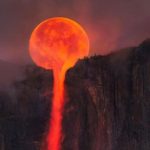Key Takeaways:
- Recent research proposes a primordial black hole as an alternative to Planet Nine, challenging established theories.
- Unusual orbits of Trans-Neptunian Objects (TNOs) hint at the existence of a massive, hidden celestial body in the outer solar system.
- Advocates of the Planet Nine hypothesis suggest a colossal planet guides these TNOs into their atypical trajectories.
- The new theory posits a primordial black hole, formed shortly after the Big Bang, could be responsible for the peculiar orbits.
- Gravitational anomalies observed by the Optical Gravitational Lensing Experiment (OGLE) hint at the potential presence of a black hole.
In the outer reaches of our solar system, a mystery unfolds. The orbits of distant celestial bodies defy conventional explanation, hinting at the presence of a colossal, enigmatic world known as Planet Nine. However, a recent research paper posits a theory that transcends even this extraordinary proposition. According to this study, our solar system might host one of the earliest entities in the universe—a primordial black hole.

In recent years, astronomers have unearthed a collection of peculiar objects in the distant solar system. These Trans-Neptunian Objects (TNOs) display not only unanticipated characteristics but also converge in their closest approach to the Sun within a remarkably consistent region of space. This behavior challenges established theories of our solar system’s structure, as even the closest known planet, Neptune, seems incapable of orchestrating these unusual orbits.
To resolve this perplexity, a team of astronomers has introduced a daring hypothesis. They propose the existence of a behemoth planet, five to fifteen times the mass of Earth, lurking beyond Pluto, hundreds of times farther from the Sun than our own planet. According to proponents of the Planet Nine theory, this colossal celestial body plays the role of a cosmic shepherd, directing the TNOs into their unorthodox trajectories.
Yet, a new revelation emerges in a research paper published on the preprint site arXiv. This study contends that Planet Nine might not be the solitary explanation for the TNOs’ orbits. Instead, it suggests a primordial black hole, an entity theorized to have materialized moments after the Big Bang, could be the underlying cause. This hypothesized black hole, akin in mass to approximately five Earths, would be astoundingly compact—only about the size of a baseball.
The researchers draw attention to an array of gravitational peculiarities recently identified by the Optical Gravitational Lensing Experiment (OGLE). This project monitored the cosmos in search of gravitational microlensing events, where a massive foreground object, such as a black hole, passes in front of a background object like a star. If perfectly aligned, the foreground object acts as a lens, distorting and amplifying the light from the object behind it.
Based on five years of OGLE observations, researchers unveiled six anomalous microlensing events involving objects roughly 0.5 to 20 times the mass of Earth. According to the paper, these objects, positioned about 26,000 light-years away towards the Milky Way’s galactic bulge, could potentially be an unexpected population of primordial black holes rather than free-floating planets.
The authors of the study suggest, “Capture of a free-floating planet is a leading explanation for the origin of Planet [Nine], and we show that the probability of capturing a [primordial black hole] instead is comparable.” If indeed a black hole was captured by the Sun and now roams the outer solar system, it could exert the same gravitational influence on the orbits of eTNOs as Planet Nine.
While Konstantin Batygin, a key proponent of the Planet Nine hypothesis, acknowledges the possibility of a primordial black hole in their model, he underscores that the calculations can only determine the mass of Planet Nine, not its composition. Thus, it could theoretically be a planet, a black hole, or any other dense object, as long as its orbital characteristics align.
Batygin, while not entirely swayed by the black hole theory, maintains an open-minded perspective. He suggests, “I always like to keep an open mind.” This sentiment encapsulates the essence of scientific inquiry—an unwavering commitment to explore even the most unconventional possibilities, as we continue to unravel the mysteries of our cosmic neighborhood.


